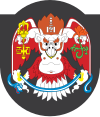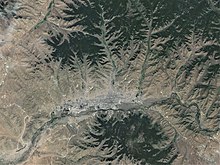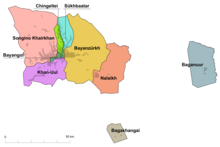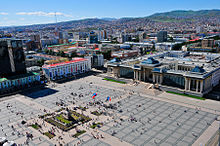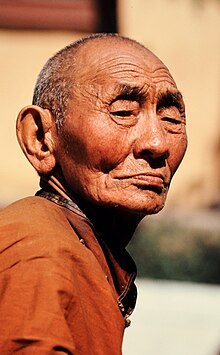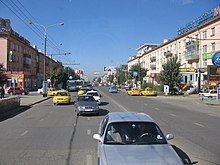Ulaanbaatar
|
Ulaanbaatar Улаанбаатар ᠤᠯᠠᠭᠠᠨᠪᠠᠭᠠᠲᠤᠷ |
|||
|
|||
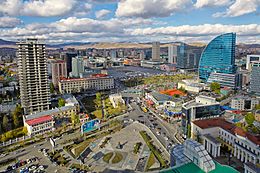 View of Ulaanbaatar with the Blue Sky Tower |
|||
| Country: |
|
||
| Aimag : | Ulaanbaatar (Capital District) | ||
| Founded: | 1639 | ||
| Coordinates: | 47 ° 55 ' N , 106 ° 55' E | ||
| Height: | 1350 m | ||
| Surface: | 4,704.4 km² | ||
| Residents: | 1,462,973 (2017) | ||
| Population density: | 311 inhabitants per km² | ||
| Time zone: | UTC + 8 | ||
| Telephone code: | +976 (0) 11 | ||
| Post Code: | 210 xxx | ||
| License Plate: | УБ_, УН_ | ||
| Website: | |||
|
|
|||
Ulaanbaatar ( Mongolian Улаанбаатар , Mongolian ᠤᠯᠠᠭᠠᠨᠪᠠᠭᠠᠲᠤᠷ German 'Red Hero' ; widespread spelling in Russian Улан-Батор : Ulan-Bator or Ulan Bator ; founded as Örgöö , formerly called Urga in Europe ) is the capital of Mongolia .
Almost half of the total Mongolian population, around 1,462,973 people, live in the Mongolian capital.
The capital is the political, economic and cultural center of Mongolia. The city forms an independent administrative unit and does not belong to any aimag (province). The administrative area of Ulaanbaatar is not a contiguous urban area, but with its low population density and the dominant rural settlement structure outside the actual city, it is more comparable to a small province. In addition, the exclaves Bagakhangai and Baganuur are part of the urban area.
The natural history museum, the Süchbaatar monument on the square of the same name, the winter palace of Bogd Khan and the Dsaisan monument , which commemorates the Second World War , are of tourist significance . It is located on a hill south of the city from which you have a nice view. The public library has a unique collection of Sanskrit manuscripts from the 11th century. The Buddhist temple museums and the Gandan Monastery are also worth visiting.
geography
Ulaanbaatar is located at an altitude of 1350 meters on the Tuul River and at the foot of the 2256 meter high mountain Bogd Khan Uul . The administrative area of Ulaanbaatar has an area of 4704.4 square kilometers and is therefore about twice the size of the Saarland .
history
The city was founded in 1639 under the name Örgöö (therefore also known as Urga in Europe until the 20th century ) as the seat of the head of Lamaism in Mongolia, the Jebtsundamba Khutukhtu (also called Bogd Gegen). In the first century and a half it changed its location more than 25 times, and has been in its current location since 1778. It also changed its name several times: from 1706 it was called Ich-Chüree ( Их-Хүрээ ), from 1911 to 1924 it was called Niislel-Chüree , from 1924 finally Ulaanbaatar , which in the Russian spelling Ulan-Bator ( Улан-Батор ) in became known to the world. The reason for the difference is that the Cyrillic script was only introduced 17 years later in Mongolia and by that time a phonetic spelling based on Russian pronunciation had already been established in Russia.
As a result of the signing of the Treaty of Aigun in 1858, the city's economic importance grew from the 1860s onwards due to trade between Russia and China , and it was also the seat of the Chinese Amban . 1911 declared the eighth Bogd Against the Outer Mongolia independent. In the same year the city was renamed Niislel Chüree . China did not recognize the secession , but granted Outer Mongolia certain rights of autonomy with the Treaty of Kyakhta in 1915 .
In 1920/21 troops of the Russian White Army occupied the country and on March 13, 1921 proclaimed an independent monarchy in Niislel Chüree . Shortly thereafter, the Soviet Red Army captured the city and established a puppet government on July 3, 1921 . On July 13, 1924, Outer Mongolia was declared a “ People's Republic ” as the first Soviet satellite regime of its kind . In this context, the city was named Ulaanbaatar (Russian: Ulan Bator; in German: "Red Hero") and was declared the capital of the Mongolian People's Republic on November 26, 1924 .
The collapse of the Soviet Union inevitably led to the collapse of its puppet regime in Ulan Bator. After mass demonstrations in the winter of 1989/90, the communist state party lost more and more control. In March 1990 the entire Politburo resigned, and in May the one-party system was abolished , which marked the beginning of the democratization process and the turn to a market economy. On July 29, 1990, the first free elections took place in a multi-party system. On February 12, 1992, Parliament sealed the end of the communist system with the adoption of a new constitution. At the same time the constituent power renounced the designation People's Republic . This made Ulaanbaatar the capital of the new state of Mongolia .
| year | 1979 | 1989 | 2000 | 2010 | 2016 |
|---|---|---|---|---|---|
| Residents | 403,000 | 548,400 | 760.077 | 1,159,899 | 1,380,792 |
Sights and culture

Ulaanbaatar is a city between modernity and tradition. The center of the city is Süchbaatar Square . The most striking buildings on this spacious square are the Parliament Building , the City Hall , the House of Culture, the State Opera, the Mongolian Stock Exchange and some modern high-rise buildings with hotels, restaurants and shops. In front of the entrance to the parliament building there are large sculptures: in the middle Genghis Khan , right and left his son and successor Ögedei Khan and his grandson Kublai Khan , once Emperor of China.
There are various testimonies of Lamaism in the city , such as the Gandan Monastery , the Winter Palace of Bogd Khan or the Choidschin Lama Temple Museum . The Gandan Monastery is west of the city center. It is the largest monastery in the country and one of the few original monasteries that survived the Stalinist terror in Mongolia . Nevertheless, Soviet troops also destroyed several buildings here and had the 26-meter-high golden statue of the goddess Janraisig ( Sanskrit : Avalokiteshvara ) dismantled and melted down in front of the monastery. Thanks to donations from the Buddhist community of the equivalent of 5 million US dollars , a new gold-plated Janraisig was built after 1990. A new throne chair was built for the Dalai Lama , the actual head of the monastery.
Museums

There are numerous museums in the city, the largest of which is the Natural History Museum , with a paleontology section with several dinosaur skeletons. The National Historical Museum is also worth mentioning . It is known for the ethnographic and historical exhibition, which gives an insight into nomadism and the history of the Mongols. The G. Zanabazar Art Museum shows the ancient art of Mongolia. The focus is on the Buddhist works of art by Dsanabadsar . Sculptures, pictures and tankas give an overview of Buddhism in Mongolia.
The Museum of Fine Arts shows classical and modern painting, as well as handicrafts of Mongolia. The Natsagdorsch Museum was built in honor of the most important writer of Mongolia Daschdorschiin Natsagdorsch . In the 1920s, Natsagdordsch was studying in Germany. His early death in 1937 at the age of only 31 is surrounded by many rumors. The museum is located right next to the Choidschin Lama Temple.
The Ulaanbaatar City Museum gives an insight into the history of the city of Ulaanbaatar. The Camel Museum houses 250 exhibits related to the Bactrian camel . The Toy Museum displays popular games and toys from Mongolia. The museum is located in the building of the “Mongolian National Center for Children” on the top floor.
The hunting trophy museum gives a little insight into the animal world of Mongolia. The railway museum is also worth a visit . The Mongolian Theater Museum is famous for its puppet exhibition. The museum is located on the third floor of the Kulturpalast. The Museum of Arts and Creativity of Children shows the creativity of the children and youth of Mongolia. The Mongolian Military Museum was inaugurated on the 50th anniversary of the end of the Second World War. There are exhibits from all periods of Mongolian military history.
The Museum of the Politically Persecuted was established by a daughter of Peldschidiin Genden , a prime minister who was executed in the Soviet Union in the 1930s. It is reminiscent of the Stalinist terror in the 1930s , the number of which is estimated at 35,000 to 36,000 deaths. In total, the research assumes more than 100,000 persecuted people, and the number of victims is very likely significantly higher.
theatre
Ulaanbaatar is home to several theaters and theater companies, such as the State Drama Theater, State Opera, Ballet and the Folk Song and Dance Ensemble.
Regular events
- Naadam : Once a year, on July 11th, the country's largest festival takes place. Men and women from all over the country come here to compete in wrestling (men only), horse riding and archery.
- City marathon : On June 5, 2010, a city marathon took place in Ulaanbaatar for the first time. In the meantime, the first Saturday in June has been declared "Marathon Day" by the city parliament and membership in the Association of International Marathons and Distance Races (AIMS) has been applied for.
education
- National University of Mongolia : The only modern university in the country, founded in 1942, is located in Ulaanbaatar, as is the library, which is known for its ancient Mongolian, Chinese and Tibetan scripts.
Other important educational institutions are:
- the American Center For Mongolian Studies
- the Mongolian State University of Agriculture
- the National Medical University of Mongolia
- the Ulaanbaatar Medical School
Healthcare
In general, the health system in Mongolia is regulated by the state. Every officially employed Mongol pays into compulsory state insurance, medical care is free for all Mongolians. Compared to the West, the health system has a small budget and is supported in many areas from abroad. The Tibetan medicine is widespread in some regions and can at the Buddhist University, and foreigners, are assigned as a subject.
With the Grand Med Hospital , which treats more than half a million patients per year, Ulaanbaatar is one of the leading hospitals in Mongolia. Other major hospitals in Ulaanbaatar are:
- Infection Hospital (Bajandsürch düüreg)
- Military hospital (Bajandsürch düüreg)
- Mother and Child Hospital No. 1 (Bajangol düüreg)
- Oncological Hospital (Bajandsürch düüreg)
- Accident Hospital (Bajangol düüreg)
- University Hospital No. 1 (Süchbaatar düüreg)
- University Hospital No. 2 (Bajandsürch düüreg), only for government or senior citizens
- University Hospital No. 3 (Bajangol düüreg)
There are also many small hospitals and some private hospitals.
The Veterinary Institute has become an important element of nomadic livestock farming since the 1950s. It studies diseases that have occurred and is constantly developing new vaccines that are distributed to shepherds in nationwide campaigns.
economy
Ulaanbaatar is supplied with coal from nearby areas and is also the industrial center of the country. On the outskirts there are u. a. Power plants.
traffic
The Mongolian road and air network is concentrated in the city, and the Trans-Mongolian Railway also runs through Ulaanbaatar. It connects the city with the Trans-Siberian Railway and the Chinese railway network. There are direct trains to Moscow and Beijing. Chinggis Khaan International Airport is located near Bujant-Uchaa, just outside Ulaanbaatar . The airline MIAT operates regular scheduled services from Ulaanbaatar to Berlin , Moscow , Beijing , Hong Kong , Tokyo and Seoul .
The Ulaanbaatar trolleybus and numerous bus routes operate within the city . The urban road network is continuously being improved, but still requires major investments.
climate
With an annual average temperature of −2 ° C, Ulaanbaatar is considered the coldest capital in the world. This is mainly due to the extremely cold winter months with temperatures averaging −17 to −21 ° C (during the day −10 to −15 ° C, at night around −25 ° C). In summer, on the other hand, it is quite warm with average values of 15 to 17 ° C (around 20 ° C during the day, 10 ° C at night), and in midsummer the maximum temperatures are up to 30 ° C.
As before, families move to the countryside as traditional nomads during the summer months and only live in the city during the cold season.
| Ulaanbaatar | ||||||||||||||||||||||||||||||||||||||||||||||||
|---|---|---|---|---|---|---|---|---|---|---|---|---|---|---|---|---|---|---|---|---|---|---|---|---|---|---|---|---|---|---|---|---|---|---|---|---|---|---|---|---|---|---|---|---|---|---|---|---|
| Climate diagram | ||||||||||||||||||||||||||||||||||||||||||||||||
| ||||||||||||||||||||||||||||||||||||||||||||||||
|
Average monthly temperatures and rainfall for Ulaanbaatar
Source: WMO ; wetterkontor.de
|
|||||||||||||||||||||||||||||||||||||||||||||||||||||||||||||||||||||||||||||||||||||||||||||||||||||||||||||||||||||||||||||||||||||||||||||||||||||||||||||||||||||
Administrative structure
Ulaanbaatar is divided into nine districts called Düüreg , and these in turn into sub-districts - Choroos .
The city is governed by a council of representatives with 40 members who are each elected for a four-year term.
| Düüreg (District) | Mongolian | Number of Choroos |
Population (January 1, 2006) |
Population (January 1, 2007) |
Annually Growth (percent) |
Area km² |
Density / km² |
|---|---|---|---|---|---|---|---|
| Bajangol | Баянгол | 20th | 160,479 | 160,818 | 0.2 | 29.5 | 5451.5 |
| Tschingeltei | Ингэлтэй | 18th | 130.501 | 132,883 | 1.8 | 89.3 | 1488.1 |
| Süchbaatar | Сүхбаатар | 16 | 117.233 | 123.041 | 5.0 | 208.4 | 590.4 |
| Chan-Uul | Хан-Уул | 14th | 87,912 | 90,925 | 3.4 | 484.7 | 187.6 |
| Songinochairchan | Сонгинохайрхан | 21st | 204,587 | 211.056 | 3.2 | 1200.6 | 175.8 |
| Bajandsürch | Баянзүрх | 20th | 196.132 | 211,614 | 7.9 | 1244.1 | 170.1 |
| Baganuur | Багануур | 4th | 25,261 | 25,731 | 1.9 | 620.2 | 41.5 |
| Nalaich | Налайх | 6th | 26,529 | 27,297 | 2.9 | 687.6 | 39.7 |
| Bagachangai | Багахангай | 2 | 3,776 | 3,827 | 1.4 | 140.0 | 27.3 |
| All in all | 121 | 952.410 | 987.192 | 3.7 | 4704.4 | 209.8 |
Town twinning
-
Denver , United States

-
Gold Coast , Australia

-
Seoul , South Korea

-
Taipei , Taiwan

-
Tianjin , People's Republic of China

-
Ankara , Turkey

Personalities
- sons and daughters of the town
- James Victor Uspensky (1883–1947), Russian-born American mathematician
- Rinchen Barsbold (* 1935), Mongolian vertebrate paleontologist
- Jigdschidiin Mönchbat (1941–2018), Mongolian wrestler
- Mendsaichaniin Enchsaichan (* 1955), Prime Minister of Mongolia from 1996 to 1998
- Sandschaagiin Bajar (* 1956), Mongolian politician and 2007-2009 Prime Minister of Mongolia
- Nambaryn Enchbajar (* 1958), Mongolian politician and 2005–2009 President of Mongolia
- Nergüin Enchbat (* 1962), Mongolian boxer
- Süchbaataryn Batbold (* 1963), Mongolian politician and 2009–2012 Prime Minister of Mongolia
- Chaltmaagiin Battulga (* 1963), politician; President of Mongolia since 2017
- Munkhbayar Dorjsuren (* 1969), German sports shooter of Mongolian origin
- Sangidordschiin Sansargereltech (* 1969), Mongolian composer
- Byambasuren Davaa (* 1971), Mongolian documentary filmmaker and director
- Otrjadyn Gündegmaa (* 1978), Mongolian sports shooter
- Asashōryū Akinori (actually Dolgorsürengiin Dagwadordsch) (* 1980), former Mongolian sumo wrestler and the 68th yokozuna
- Asasekiryū Tarō (* 1981), sumo wrestler
- Otgonbayar Ershuu (* 1981), Mongolian artist
- Nomin Bold (* 1982), Mongolian painter
- Uisenma Borchu (* 1984), German-Mongolian director and actress
- Harumafuji Kōhei (* 1984), former Mongolian sumo wrestler in the Japanese makuuchi division and the 70th yokozuna
- Enchbatyn Badar-Uugan (* 1985), Mongolian boxer
- Hakuhō Shō (actually Mönchbatyn Dawaadschargal) (* 1985), Mongolian sumo wrestler and the 69th yokozuna
- Batchimeg Tuvshintugs (* 1986), Mongolian chess player
- Batchujagiin Möngöntuul (* 1987), Mongolian chess player
- Bilguun Ariunbaatar (* 1986), Polish television presenter and satirist of Mongolian origin
- Terunofuji Haruo (* 1991), Mongolian sumo wrestler in the Japanese makuuchi division
- Njambajaryn Tögstsogt (* 1992), Mongolian boxer
Panoramic photos
Web links
- ulaanbaatar.de (German)
- Article in the NZZ: "The dream of the tenters of concrete"
- Changing Ulaanbaatar (English)
- Population figures in Ulaanbaatar
Individual evidence
- ^ Mongolian Statistical Information Service
- ↑ Mongolia: Provinces, Major Cities & Urban Settlements - Population Statistics, Maps, Charts, Weather and Web Information. Retrieved November 25, 2017 .
- ^ Robert Arthur Rupen: Mongols of the Twentieth Century. Indiana University, 1964, p. 276.
- ↑ Christian Koller: Collective Nomads: The founding of the People's Republic of Mongolia 85 years ago, in: Rote Revue - magazine for politics, economy and culture 86/3 (2009). P. 31.
- ^ CR Bawden: The Modern History of Mongolia. Routledge 1968, p. 216 f.
- ↑ Eva-Maria Stolberg : Stalin and the Chinese Communists. A study of the history of the origins of the Soviet-Chinese alliance against the backdrop of the Cold War. Franz Steiner Verlag, 1997, p. 113.
- ↑ Michael Reinhardt: Constitutional Effects of Perestroika in Outer Mongolia. in: Recht in Ost und West , 1993, p. 6 ff.
- ↑ Kay Möller: Textbook. The Foreign Policy of the People's Republic of China 1949–2004. An introduction. Springer-Verlag, 2005, p. 159.
- ↑ Mongolia: Provinces, Cities & Urban Settlements - Population Statistics, Maps, Charts, Weather and Web Information. Retrieved April 23, 2018 .
- ^ Daniel Schmückin, Raffaela Helf: The processing has started. Political persecution in socialist Mongolia. in: Country reports, Konrad-Adenauer-Stiftung eV, January 2017, p. 1.
- ↑ Statistical Office of the City of Ulaanbaatar, http://statis.ub.gov.mn/Download/Research/pop2006.01.01.pdf ( Memento from February 22, 2007 in the Internet Archive ) http://statis.ub.gov.mn /Download/tan/2007/stat2701.pdf ( Memento from March 19, 2007 in the Internet Archive ) , accessed on February 16, 2007
